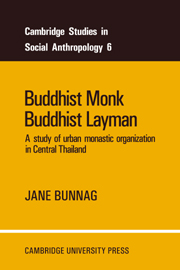Book contents
- Frontmatter
- Contents
- List of tables
- List of illustrations
- Preface
- Map A Thailand
- Introduction: the Thai social system
- 1 ‘The way of the monk’
- 2 The monk and the lay community
- 3 The wat community
- 4 The wat and its social matrix
- 5 The role of the Buddhist layman
- 6 The loosely structured social system: red herring or rara avis?
- Appendixes
- Bibliography
- Index
4 - The wat and its social matrix
Published online by Cambridge University Press: 06 January 2010
- Frontmatter
- Contents
- List of tables
- List of illustrations
- Preface
- Map A Thailand
- Introduction: the Thai social system
- 1 ‘The way of the monk’
- 2 The monk and the lay community
- 3 The wat community
- 4 The wat and its social matrix
- 5 The role of the Buddhist layman
- 6 The loosely structured social system: red herring or rara avis?
- Appendixes
- Bibliography
- Index
Summary
As a bee without harming the flower, its
colour or scent flies away, collecting only
the honey, even so should the sage wander
in the village.
The Dhammapada verse 49, translated by Narada Thera (John Murray, London, 1959)As its title indicates, the present chapter is specifically concerned with the relationship between the monastic community and the householders who contribute money and material goods, as well as time and labour, to its support. Which is to say that we shall be exploring the reality behind some of the phrases, familiar from anthropological studies of Theravada Buddhist societies; phrases such as, ‘The monks beg their food from the laity’, or ‘The monastery is the focal point of the lay community’.
In an earlier chapter I spoke of the phuak wat, as a grouping or collectivity of lay people owning a common allegiance to a particular monastery. It may be recalled that the bhikkhus in any wat normally receive invitations to perform merit-making ceremonies from laymen in the vicinity who are regarded, and regard themselves, as belonging to the phuak of that wat.
In subsequent paragraphs, where I describe the transactions which take place between the laity and the monastic community as a whole, the form and function of the phuak wat is defined more clearly, as is its relationship with other groupings and categories of people variously associated with the same monastery.
- Type
- Chapter
- Information
- Buddhist Monk, Buddhist LaymanA Study of Urban Monastic Organization in Central Thailand, pp. 100 - 141Publisher: Cambridge University PressPrint publication year: 1973



